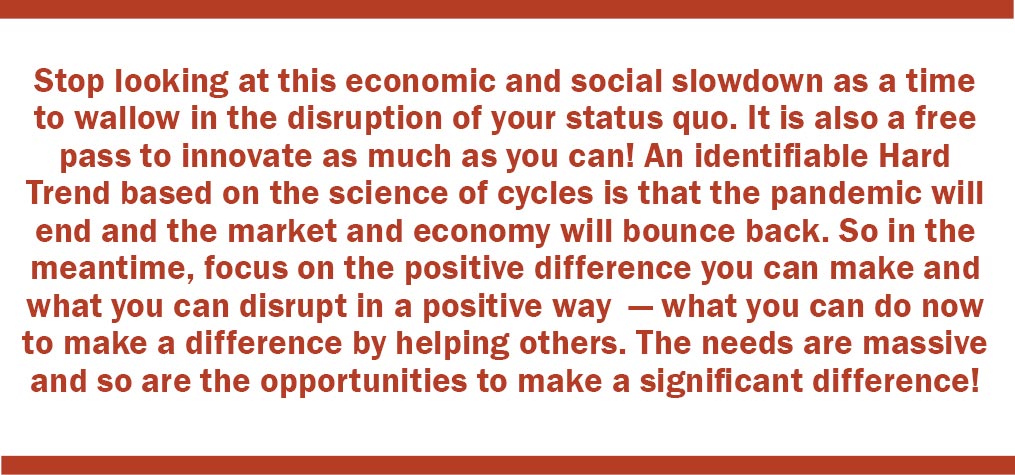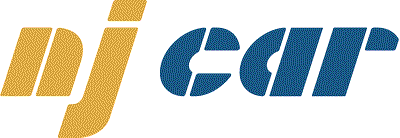By Daniel Burrus
Traditionally, when an individual or organization fears change, it has something to do with digital technology disrupting their status quo. Will something autonomous replace my job? What if something is created that puts me completely out of business?
Aside from digital transformation, another wave of fear comes from new, fast-moving competition and the threat of loss of relevance and market share.
I have discussed, at length, these fears, how to see disruption and change before they strike, and, most importantly, how to identify and act on the opportunities they represent.
Few would have thought, in the early stages of 2020, our economy would be in a downturn, we would be instantly converted to remote work or, unfortunately for some, laid off, and we would be quarantined to our homes due to a global pandemic.
Real-World Dystopia
Whether you’re in business or not, ever since the Great Recession about a decade ago, it seems the majority of individuals will not admit to their tendency to sleep with one eye open on the economy. This “hope for the best but expect the worst” attitude can be useful, but it can also be dangerous, both for your health and well-being, and for your entrepreneurial ability to see and act on the many new opportunities disruptive change presents.
Unfortunately, the COVID-19 pandemic has, to a great extent, suppressed our positive, innovative mentality as a species, and has sent many of us into a primordial tailspin of trying to get back to the way things were — the status quo. Due to fear, we are finding ourselves in a real-world dystopian society, where individuals buy in bulk unnecessarily, prepping for the end of the world.
The pandemic will end and we will recover to another new version of normal. What if we made the new post-pandemic normal much better than what we had before? Is that possible?
It sure is, if we get past fear and reacting to the next disruptive problem and become anticipatory, using the power of disruptive change to create a better tomorrow for all.
Keep in mind that while times are highly uncertain in an all-encompassing way, this global disruption on a massive scale is also creating new ways to have a positive, significant impact on the present and the future.
Going Remote, No Matter Who
A global pandemic, shutdown, and quarantine are very similar to digital disruption: They know no boundaries and will disrupt every industry there is. However, what this pandemic disruption is showing us is that many organizations are quickly shifting to reposition their workforce to new roles or remote roles by digitally banding together and working efficiently from a distance.
It is easy to consider going remote when you have a desk job or a career that is already rooted in flex-time industries. However, what about those that don’t have it as easy?
Virtual reality and augmented reality (VR and AR) are two technologies that have started gaining traction in recent years, given the exponential changes of the Three Digital Accelerators of bandwidth, computing power, and processing power. Now more than ever, we can see industries — which ordinarily are unable to go remote because they were based on the need for a customer to be physically present — figure out ways to provide a remote customer experience.
An incredibly outside-the-box example can be found by way of museums, zoos, and even theme parks going remote. Monterey Bay Aquarium and Walt Disney World have gone remote using live-streaming video and a form of virtual reality applications like Google Street View, so guests having to cancel their vacation can still “walk through” Disney World with their families for something to do.
If Walt Disney World, an in-person entertainment giant with visceral experiences, can find a way to go remote, imagine the remote possibilities in several other industries around the world.

Innovation Is Needed More Than Ever
While our worlds may seem to be in a period of indefinite stasis, the world and peoples’ needs don’t stop. A Hard Trend most people take for granted is that there are more than 500 cycles that continue, such as the sun setting tonight and rising tomorrow, the stock market going down and going up, and the pandemic beginning and ending.
I want us all to become positive disruptors, creating the disruptions that need to happen in order to make the world a better place for all.
Being a disruptor during times like these might sound contrary to what people want. However, when you’re a positive disruptor, you choose significance over success, focusing much less on you and what you have done, and more on what you can do for others in a significant way.
When you look for ways to elevate your significance in times like these, you can find new ways to change your community, your state, your nation, and, if you think big enough, even the world for the better. I can’t think of a more needed time than right now. Ask yourself: What can you and your organization do now that would have a significant impact on others?
Stop looking at this economic and social slowdown as a time to wallow in the disruption of your status quo. It is also a free pass to innovate as much as you can! An identifiable Hard Trend based on the science of cycles is that the pandemic will end and the market and economy will bounce back. So in the meantime, focus on the positive difference you can make and what you can disrupt in a positive way — what you can do now to make a difference by helping others. The needs are massive and so are the opportunities to make a significant difference!
Looking for Opportunity in Helping Others
This pandemic has inadvertently leveled the playing field; therefore, no one is safe from disruption, and this global disruption is happening a lot faster than digital disruption. We’re all in the same boat, so one major way to innovate is to find ways to help your customers through this in ways you haven’t thought of before. You’re thinking too small if you are thinking of offering them a discount on your product or service. It’s better to look at their desperate needs now and ways that help them stay afloat, which in turn might help you stay afloat.
This concept isn’t solely constrained to business and customer relationships. This touches on the topic of thinking about your employees who rely on you. You may be in business as a unified organization, but an employee now working remotely with kids at home and having to now think in terms of profits and losses in their personal life has unmet needs as well that you need to think about and act on. As you work to keep the doors open, what are you doing to take care of your own?
Let’s return to the entertainment industry with an example of the National Basketball Association shutting down during this crisis. While it is no secret that owners, players, and team affiliates will be financially okay during this situation, the workers at the snack bars, restaurants, and merchandise stores will feel a major financial impact, if they can survive at all. However, many teams have stepped up and donated portions of their salaries to cover the losses the service employees will feel while out of work, which in turn incentivizes them to continue to work for the stadiums and gives them a sense of belonging to the organization.
That has already created a positive change throughout the rest of the NBA, as other teams follow suit and help their fellow man and woman when in need. This positive disruption is spreading to other sports faster than any virus!
Anticipation Will Get You Through This
Hard times will pass, but the Hard Trend in times of complete uncertainty is that a new day will dawn with new opportunities to make a significant difference unfolding with it. There will be a tomorrow, so what are you doing to anticipate, innovate, and seize the opportunity it brings with it? Are you using this pandemic to be a positive disruptor, or will COVID-19 close your business’ doors for good? It doesn’t have to.
As a good friend of mine has said, “It’s not what happens to you. It’s what you do about it.” The way I see it, COVID-19 isn’t our biggest problem, it’s what we are doing, or not doing about it. One of my principles is this: Take your biggest problem and skip it. The real problem for your business isn’t the virus, it’s how you are reacting to it. Don’t panic. Focus on defining the real problem both you and your customers are having and use the certainties found in Hard Trends to reveal a solution.
There will be a future after the pandemic. If you are anticipatory, pre-solving predictable problems before you have them and becoming a positive disruptor creating the transformations that need to happen, you will find the future is bright.
Identifying Hard Trends
A well-worn cliché says there are only two things you can be certain about: death and taxes. With apologies to those who agree with that statement, there are many, many more examples of out-and-out certainties. Was Sunday followed by Monday last week? Absolutely. Will that be the case next week? You can count on it.
A more timely and, in some ways, comforting example involves the ever-changing situation we find ourselves in today with COVID-19. This pandemic has seemingly pressed pause on time, stifling businesses in many ways and rattling humankind as we’re told that each day is fluid, and we’re not sure what the next day will bring. Monday will still follow Sunday, but will it be business as usual? Right now, the answer is no.
But if Hard Trends or future certainties are as easy to identify as I maintain, what is the Hard Trend in all of this? It’s as obvious as my days-of-the-week anecdote above: This virus will end, and that is a fact that will happen. Because of this, you better believe that, aside from the length of the coronavirus’s impact, there are still Hard Trends in every industry, plus plenty of opportunity in the disruption that is this global pandemic.
In order to be able to identify Hard Trends during these unprecedented times, we must diagnose the very concept of Hard Trends and how they can lead to significant game-changing opportunities for you and your organization.
What’s a Hard Trend?
A Hard Trend is a future certainty, in that it is something we know is going to occur whether we want it to or not. Opposite of Hard Trends are Soft Trends, which are future possibilities that may or may not take place. In the case of Soft Trends, these can be changed to your, and your organization’s, benefit.
To further explore my Hard Trend Methodology and how it can help you be more anticipatory during times like we currently face, I have grouped Hard Trends into three primary categories for identification purposes.
- Demographics. This can be age, race, gender, or any other defining characteristic of a group. During this pandemic, an example is an older generation like the Baby Boomers. The fact that they are more susceptible to COVID-19 is a definite Hard Trend.
- Government Regulations and Oversight. For this category, a broad question immediately comes to mind: As a general rule, will there be more or less government regulation in the future? If we’ve learned anything from the coronavirus pandemic, it is that there will definitely be more. As new innovations emerge amid the lockdown, new governmental regulations will evolve in response to them. This is true, regardless of the industry or organization, making this a Hard Trend.
- Technology. From the ever-increasing accessibility of 3D printing to holographic telepresence, technology is inevitably going to become more functional, more sophisticated and more widespread. In addition to how we have learned to use already-existing technology during the pandemic, this makes technology in any capacity a Hard Trend; we will always be finding a newer, better way to accomplish a task or create something.
Why Hard Trends Matter
Knowing that something is a future certainty means so much more in times like these. It’s central to your organization’s planning and subsequent execution of innovation, even during an economic shutdown.
In terms of government regulation, coupled with the ever-changing spectrum of this pandemic and subsequent lockdown, being aware of the Hard Trend of growing government regulation allows you to become more anticipatory with those additional guidelines foremost in your mind, allowing you as an organization to continue to progress and grow.
Leveraging Hard Trends to your advantage is how you can also pre-solve problems before they exist. Case in point: When the United States government mandated a stay-at-home order, closing the physical operations of many nonessential businesses, many threw up their hands in frustration, while others decided to adapt and overcome, taking advantage of opportunities to continue to operate during a shutdown — and profited accordingly.
What you can expect is that Hard Trends — identified and acted upon — can offer enormous opportunities for those organizations with the mindset of always keeping their eyes open to the future.
Is your organization identifying and acting on the visible Hard Trend certainties in your industry during COVID-19? Better yet, are you learning how to be an anticipatory leader in all of this?
This story appears in Issue 2 2020-21 of the New Jersey Auto Retailer Magazine.










